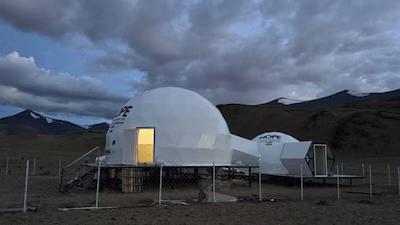
ISRO Sets Up Station in Ladakh to Simulate Life on Moon & Mars
In a groundbreaking endeavor, the Indian Space Research Organisation (ISRO) has set up the Himalayan Outpost for Planetary Exploration (HOPE) in Ladakh’s Tso Kar Valley. The station, a mini-Mars environment, will test life-support systems for future lunar and Martian missions. The unique location was chosen for its extreme conditions, similar to those on Mars, making it an ideal simulation site.
The HOPE station is a 10-day simulation mission, commencing on August 1, where two crew members will undertake various tests to evaluate the performance of life-support systems, including air, water, and food supplies. The mission aims to validate the systems and technologies that will be used in future interplanetary missions.
A Mini-Mars Environment in Ladakh
The Tso Kar Valley in Ladakh was selected as the perfect location for the HOPE station due to its extreme conditions, which mimic those on Mars. The valley experiences high UV radiation, low atmospheric pressure, and extreme cold, making it an ideal simulation site. Additionally, the soil in the valley contains saline permafrost, which is similar to the Martian soil.
ISRO scientists believe that the HOPE station will provide valuable insights into the challenges of survival on Mars and the Moon. By testing life-support systems in a harsh environment, the organization can identify and address potential issues before embarking on actual missions.
Life-Support Systems Under Test
During the 10-day simulation mission, the two crew members will test various life-support systems, including:
- Atmosphere: The crew will breathe in and out of a specially designed atmosphere, simulating the Martian environment.
- Water: The crew will drink water from a filtration system, which will be tested for purity and taste.
- Food: The crew will eat pre-cooked meals, which will be tested for nutritional value and palatability.
- Waste Management: The crew will dispose of waste in a specially designed system, which will be tested for efficiency and safety.
The crew members will also conduct other tests, including physical exercises, psychological evaluations, and communication tests to ensure that the systems are functioning seamlessly.
Significance of the HOPE Station
The HOPE station is a significant step towards India’s ambitious plans to send humans to the Moon and Mars. The success of this mission will pave the way for future interplanetary missions, which are crucial for advancing human knowledge and exploration.
The HOPE station will also provide valuable insights into the challenges faced by astronauts on long-duration missions, such as isolation, confinement, and radiation exposure. By addressing these challenges, ISRO can develop more effective strategies for ensuring the health and well-being of astronauts on future missions.
Conclusion
The Himalayan Outpost for Planetary Exploration (HOPE) is a groundbreaking initiative by ISRO to simulate life on the Moon and Mars. The 10-day simulation mission in Ladakh’s Tso Kar Valley will test life-support systems, providing valuable insights into the challenges of survival on other planets. The success of this mission will pave the way for future interplanetary missions, and ISRO’s commitment to advancing human knowledge and exploration.
Source:






